Just a few days after I read about Björn’s wood fired oven adventures I stumbled about an older newspaper telling about the oven in the local history museum just 20 km from my home. Each second Saturday of the month the oven is heated and everyone is invited to come and bake their bread – just like it was done traditionally in the old communal ovens. Reading that I got very excited and wrote an email instantly, asking if they still do this as the newspaper was already a bit older.
I got a fast answer and the invitation to join the bakers group the following Saturday as the oven is still used regulary! And so, I must warn you at this point: this post is longer and with more photos than normal because I had a wonderful time in the museum!
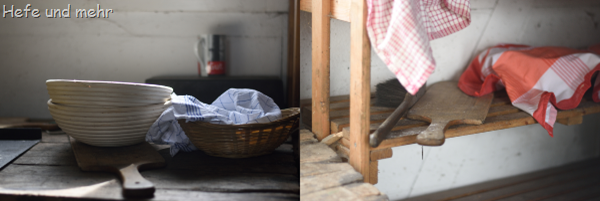
When I told my mum about the whole thing, she got as excited as I was and it was clear she would join, too. And that we would bake our family favourite was clear as well. But as I always love to play around with this recipe I decided to create a new, whole grainier variant of the bread.
The next Saturday my mum and I packed our doughs into the car. When we arrived at the museum the oven chimney was already smoking. From the oven, we found the way to the kitchen, where we formed our loaves and while they were proofing, we started to chat with our fellow bakers and learned a lot of thing about baking in a wood fired oven.
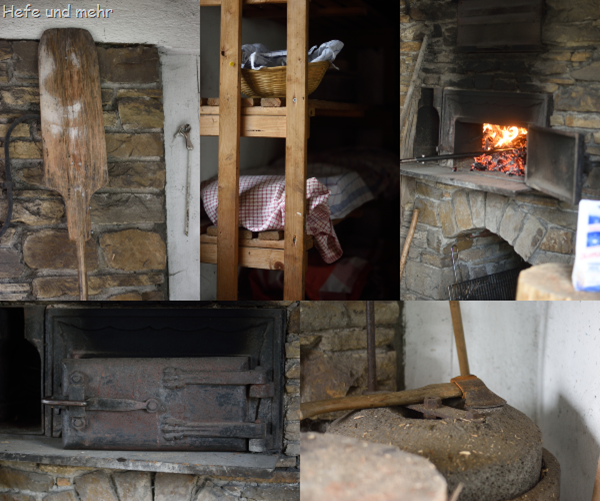
One of the bakers just started a dough for baking Baumstriezel. Baumstriezel is a yeasted cake baked over blaze on a rotating piece of wood. And while this cake belongs deeply into our Transylvanian and Hungary family history, neither my mum nor I had ever baked it the traditional way over fire. I know how to bake a smaller variant in the oven, but over fire? Never.
After the blaze where removed from the oven and the loaves where placed in the oven, it was time to bake the Baumstriezel. And as we are always curious to learn something new, we were very willing to help when someone was needed to turn the Baumstriezel over the blaze. It is amazing how fast the dough bakes and the sugar crust caramelize when you have a good blaze. And while the breads baked, we chatted and enjoyed the still warm Baumstriezel.
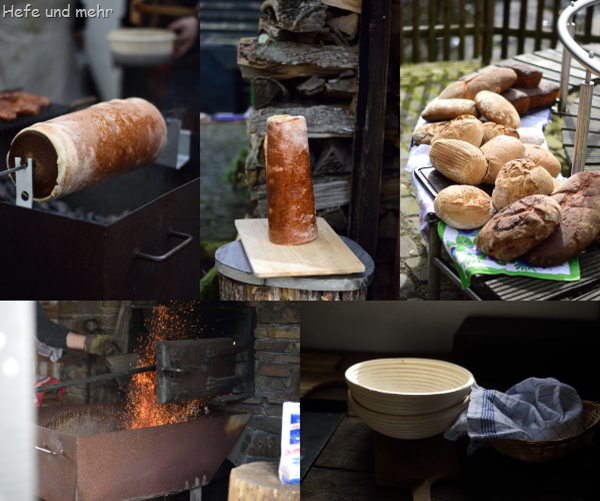
And then it was time to take the breads from the oven. After some pictures in the sun, everyone took his or her bread home. It was such a great day that I’m sad that I must wait for June before I can join there once again because the dates in April and May are both blocked with my own baking courses. But in June I will be back there, baking!
And for the new variant of our favorite bread? It turned out as great as its lighter sibling. With 50% whole wheat flour, its flavor is heartier, but as I increased the amount of water as well, the crumb similar fluffy and the crust is thick and crunchy. The fact, that it was baked in a wood fired oven added a special smoky touch to the flavor, but it tastes great from an electric oven, too!
Wheat Rye Bread Number 3
yields 2 loaves of 750g
- 90g sweet Starter
- 90g flour Type 550
- 45g Water
Sourdough
- 150g Water
- 150g Whole wheat flour
- 15g Sourdough
Dough
- Sourdough
- Sweet Starter
- 200g Whole rye flour
- 150g Whole Wheat flour
- 350g flour Type 1050
- 475g Water
- 20g inaktive Malt
- 20g Butter
- 20g Salt
- 5g fresh yeast
Mix water, flour and starter for the sourdough and ferment for about 12 -16 hours at 25°C.
For the sweet starter, Mix all ingredients for the feeding and ferment for 2-4 hours at 30°C. Store in the fridge until the next morning.
The next morning knead all ingredients 5 min at the slowest speed and 8 min at higher speed until medium gluten development.
Let rise for 2 hours.
Divide the dough into two parts. Form to round breads and place in the proofing basket seam side down
Proof for 1.5 hours, heat the baking stone at 250°C in the meantime.
Place the breads in the oven with steam. Turn the temperature back to 200°C after 10 min and bake the bread for another 45 min .
Deutsch



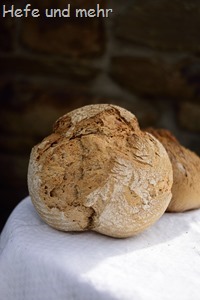
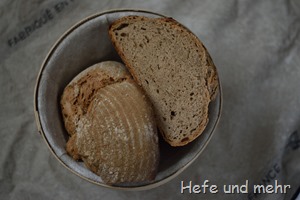
DANKE 🙂
Liebe Grüße Kerstn
Ich möchte das gesamte Weizenvollkornmehl durch Dinkelzentrofanmehl ersetzen und nur die 350g Weizenmehl im Hauptteig belassen. Allerdings WM 550, da 1050 derzeit alle.
Würde meinem Gefühl nach die kalte Autolyse allerdings nur mit dem Dinkel- und Roggenzentrofanmehl des Hautteiges ansetzen, da das Zentrofanmehl ja schon ein ganz schöner Schluckspecht 😉 ist.
Könnte ich Backmalz inaktiv durch Honig oder Rübensirup,… ersetzen? => auch gerade alle 🙁
@Kerstin: Kalte Autolyse schadet nie und gerade bei Vollkornmehlen ist es sinnvoll 🙂 Und Rübensirup oder Honig (ich würde Rübensirup nehmen) kann natürlich das Backmalz ersetzen.
Prima,
mache ich dann so!
Wie viel länger als mindestens 1/2 Std. ist denn die Autolyse bei Vollkern- oder Vollkornzentrofanmehl sinnvoll?
@Kerstin: Bei Vollkornmehl setze ich die Autolyse gerne warm für 30-60 min an (s.hier)
Hallo Stefanie,
möchte für dieses Brot anstatt Weizenvollkorn- Dinkelzentrofanmehl und statt Roggenvollkorn- Roggenvollkornzentrofanmehl nehmen.
Hast du dafür Änderungsvorschläge?
Flohsamenschalen hätte ich auch noch im Vorrat und ich möchte eher ein unkompliziertes Brot ohne zu vielel Extras.
LG
@Kerstin: Du kannst – je nach Wasseraufnahmefähigkeit deines Dinkelmehls -vielleicht noch 3g Flohsamenschale nehmen. Willst du alles Weizenmehl durch Dinkel ersetzen? Wenn nicht, würde ich erstmal den Teig ohne Flohsamenschale ansetzen. Das gut ist ja, das man Flohsamenschale ja auch noch gegen Ende des Knetvorganngs zusetzen kann, wenn man merkt, dass der Teig zu weich wird.
So, jetzt hab ich es auch endlich geschafft das Weizenmischbrot Nr. 3 zu backen.
Allerdings war mir der Teig schon nach der Autolyse viel zu weich geraten. Auf die zweite Wassergabe habe ich dementsprechend ganz verzichtet und nach ca. 15 Min. Knetzeit 2 Tl Flohsamenschale zugegeben. Nach 20 Min. das kneten dann abgebrochen und den Teig in eine Teigwanne gegeben. Nach 30 und 60 Min. gefaltet und erstaunlicherweise nach der weiteren Stunde Teigruhe einen Teig bekommen, der sich richtig gut händeln ließ.
Meine Gare war dann wohl etwas zu lang, ist nur leicht gerissen, aber das Brot ist richtig gut geworden. Saftig, kräftig, lecker und schön in der Form. Überhaupt nicht breit gelaufen 😅. Bin seeehr zufrieden!
Aaaaber für uns bleibt die Nr. 2 die unschlagbare Nr. 1 !
GlG Nicole
P.S. Hier ist noch kein Häkchen zur speichererlaubnis zu setzten ?
@Nicole: Auch bei uns ist die Nummer 2 immer noch Nummer 1. Es hat schon seine Gründe, warum meine Mutter und ich es nur als “das Lieblingsbrot” bezeichnen. Aber ein wenig Abwechslung muss ja auch sein.
Und Flohsamenschalen sind wirklich eine feine Sache. Ich bin immer wieder fasziniert, wie viel Wasser sie aufnehmen können.
Und was das Häkchen setzen angeht. Mir ist das erste Plugin für die DSGVO schon nach kurzer Zeit auf die Nerven gegangen, weil es a) im Admin-Bereich die Kommentare zerschossen hat, und b) nicht gespeichert hat, dass das Häkchen auch gesetzt wurde. Darum habe ich heute ein wenig mit Plugins gespielt und jetzt (hoffentlich) eine bessere Lösung installiert.
Hallo Stefanie, würde gerne dieses Brot nach backen habe keinen süßen Starter, kann ich meinen
LM nehmen..? Wenn ja wieviel? L. G. Danke
@Irene: Du kannst auch 225g LM verwenden.
Hallo Stefanie,
lustig, dass du gerade dann ein Rezept für den Holzbackofen postest, wenn ich mich frage, welchen Teig ich nächstes Wochenende für den Holzbackofen in Freising benutzen möchte, der auch alle zwei Wochen angefeuert wird und sich immer größerer Beliebtheit erfreut.
Ich denke, ich werde mich am Weizenmischbrot Nummer 2 versuchen. Leider fehlt es mir noch an einer Küchenmaschine. Um auch beim Kneten per Hand ein gutes Ergebnis zu erzielen, hatte ich mir überlegt, das Weizenmehl komplett durch Dinkelmehl 630 zu ersetzen und gegen das Trockenbacken ein Kochstück in den Teig einzubauen. Eine Autolyse werde ich wohl auch einbauen. Fällt dir sonst noch ein Tipp ein, das maximale Ergebnis aus dem Teig zu holen, auch wenn ich nur per Hand kneten kann (und mir leider auch die Kraft fehlt, den Teig 20 min zu bearbeiten). 😉
Lieben Gruß und danke!
Lena
@Lena: Da bringst du mich ja auf eine Idee, eine Dinkelvariante vom Lieblingsbrot bietet sich doch sehr an!
Bei einem Dinkelteig ist ein Kochstück eine gute Idee, Autolyse auch. Grundsätzlich kannst du den Teig (egal ob Dinkel oder Weizen) nach der Autolyse etwa 10 min von Hand kneten und dann alle 30 min dehnen und falten, dann baut sich das Glutennetwerk gut auf, ohne dass du 20 min am Stück kneten musst!
Na dann werde ich ab Sonntag berichten. 🙂
Hallo Stefanie,
backen im Holzofen … ein Traum ! Bei uns sind schon Brote experimentell im Smoker gelandet. Die Temperatur zu halten ist da echt schwer, dementsprechend waren diese Brote noch kein so großer Erfolg . Aber das doppelbacken könnte funktionieren, so der Plan für gutes Wetter.
Weizenmischbrot Nr. 3 werde ich auf jeden Fall, in der Backofenvariante, probieren ! Vielleicht dann auch mal im Smoker doppelgebacken.
Aber, den Ring anfeuchten Blätter und Rose aufsetzten gehört nicht ins Rezept, oder ? 😉
Grüße Nicole
@Nicole: Verflixt, das hat man davon, wenn man Rezeptbeschreibungen aus Faulheit kopiert! Ich habe es direkt korigiert, danke!